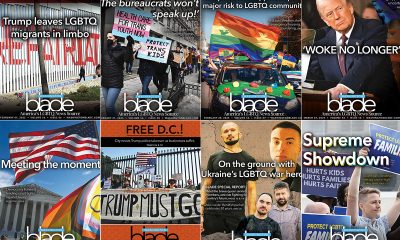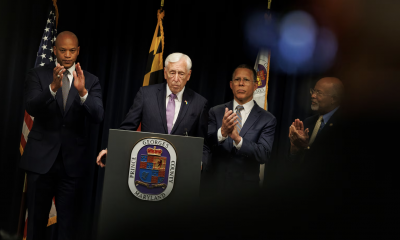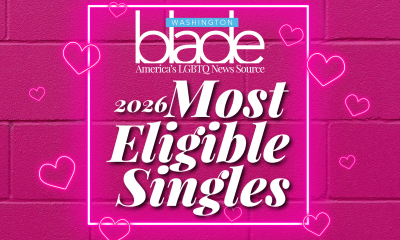Opinions
‘Because of sex’ approach to protecting trans people
Many analyses of Bostock decision missed the real history
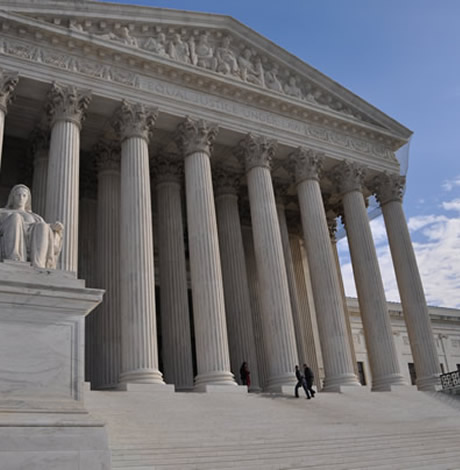
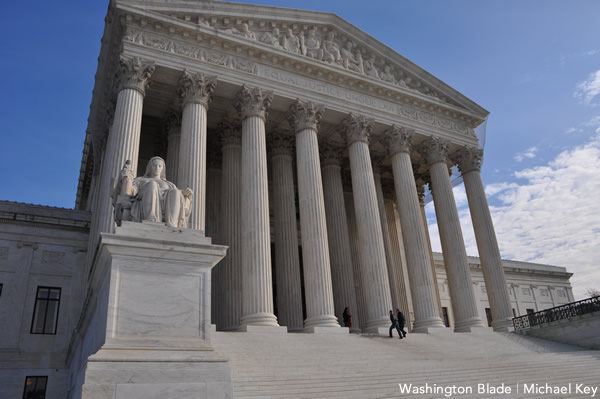
“Here, I thought, looking around me, is where it all changed, because I was still too young to understand that history is not simply made up of moments of triumph strung together like pearls. I didn’t know that large changes were made up of many small ones, and of moments of suffering and backsliding and incremental, selective progress; unnecessary sacrifices and the opportunistic, privileged and lucky walking forward over the vulnerable and the dead.” —Carmen Maria Machado
The road to LGBTQ equality has been long and winding, made up, legally, of two paths — sex (gender) stereotyping and “because of . . . sex.” Until the Bostock decision last month we had a quantum mechanical, “Schrödinger’s Cat” causal conundrum — would the decision be based on “sex” as written in Title VII of the 1964 Civil Rights Act, or “sex stereotyping” as developed in the landmark 1989 Price Waterhouse v. Hopkins Supreme Court decision? Many guessed it would be the former, “because of . . . Gorsuch” and his penchant for textualism, but that didn’t stop plaintiff Aimee Stephens’ lawyer, David Cole, from arguing with the latter. Turns out it was the former, but before I trace the social history of that path, I would like to point out a delicious irony.
It’s long been understood that the modern Supreme Court rarely leads, and usually follows, public opinion. That opinion is shaped by the people, and primarily by the people’s activist corps. In the case of the gay rights movement, the people universally known through the 1960s as homosexuals became known in the 70s as gay people. Why? Because the “sex” in “homosexual” directed one’s gaze to sex acts, which is still what most Americans conjure in their minds when they hear the word “sex.” And since many were repelled by the thought of gay sex, it became evident a different, de-sexed, label was necessary.
Similarly with the trans community, which had been universally known as the transsexual community through the 1980s, and which de-sexed “transsexual” to “transgender” in the ‘90s (the first national trans rights group, founded by Riki Wilchins and Denise Norris in 1993, was called “Transexual Menace,” and the second, was the “National Transgender Advocacy Coalition,” in 1999), and then finally just the single syllable “trans” in the aughts, to match the single syllable, “gay.” Language matters. Just as Americans viewed homosexual people through the lens of their sex acts, they viewed transsexual people the same way, often reduced to sex workers and homicidal maniacs (“Dallas Buyer’s Club,” 2013 and Hitchcock’s classic, “Psycho,” 1960).
So, today, gay and trans individuals have their employment rights, and soon full protections with the Equality Act next year, because of a return to the modern source of those rights, the Civil Rights Act of 1964, and “because of . . . sex.” Not gender, but sex, and, refreshingly so, but devoid of any implications of sexual activity. Justice Gorsuch, interestingly, returned to using the archaic term “homosexual” throughout his opinion, but did not revert to “transsexual,” and treated Ms. Stephens respectfully in his comments.
How did we get here? In the weeks following the decision many of the analyses of the decision missed the real history. That history is written by the victors, but it also very much matters which victors do the writing.
The path of “because of . . .” and “but for” sex began in the 60s, as Justice Gorsuch mentioned: Not long after the law’s passage, gay and transgender employees began filing Title VII complaints, so at least some people foresaw this potential application.
Trans persons won some lower court decisions in the ‘70s, before the religious and feminist backlash began in 1979 with Janice Raymond and then the Reaganites. Trans plaintiffs lost in the late ‘70s and ‘80s because transsexualism was not recognized as a form of sex (Holloway v. Arthur Andersen, 1977, Sommers v. Budget Marketing, 1982 and Ulane v. United Airlines, 1984). And then, in 1989, came Price Waterhouse v. Hopkins, and the landscape utterly changed for trans plaintiffs.
The first, and until Bostock, only SCOTUS decision (and victory) for a trans plaintiff occurred in 1994, in a unanimous Eighth Amendment decision written by Justice Souter on behalf of the plaintiff, a black trans woman, Dee Farmer. The next federal appeals court case, and the first in a string of victories leading to Bostock, was Smith v. City of Salem in 2004, won on both sex and sex stereotyping concerns, followed by another Sixth Circuit case, Barnes v. City of Cincinnati in 2005. Philecia Barnes was also a black trans woman and she won “because of sex.” The only hiccup in this long chain of victories was Etistty v. Utah Transit Authority in the 10th Circuit in 2007. This was followed in rapid succession by the blockbusters: Schroer v. Billington, 2008; Glenn v. Brumby, 2011; and Macy v. Holder, 2012.
It was the unanimous Macy decision at the EEOC, led by Commissioner Chai Feldblum, that protected trans persons in all 50 states, and cemented the “because of sex” approach to protecting trans persons. Professor Feldblum, a major author of the 1991 Americans with Disabilities Act (ADA), had been living in Takoma Park, Md., in Montgomery County in 2007-08 when I led the campaign for Basic Rights Montgomery to pass and defend the county gender identity law. That law generated the first bathroom bill backlash in the United States, and Professor Feldblum, who had been a believer in the doctrine that trans status was a function of sex and, therefore, covered by Title VII, was further encouraged to pursue it if she ever got her chance in the federal government to make it a reality. Presciently, these were her words 20 years ago: “But a strict textualist approach might work as well (or even better) for those seeking to achieve broad protection for gay people and transgender people. Under such an approach, the intent of the enacting Congress (or state legislature) is not as important as the words the legislature chose to use.”
It had been obvious to me, as well, as I had been teaching and lobbying for years on the medical basis of transsexualism being rooted in brain sex. Research begun in 1995 had been making that very plain. But few LGBTQ attorneys, with the notable exception of Katie Eyer, believed in the possibility of progressive textualism, even though the Constitution is the product of the Enlightenment.
So after being nominated by President Obama to the Equal Employment Opportunity Commission (EEOC) and confirmed by the Senate, Professor Feldblum looked for the right case and found it in Mia Macy. She then did the same for David Baldwin in the first national gay rights victory, Baldwin v. Foxx, in 2015.
Just looking at these cases it was clear that the federal courts (and some state courts as well) were beginning to respect trans persons enough, including black trans women, beginning in the ‘90s to not only not summarily throw them out of court, but to seriously apply the “because of sex” and sex stereotyping arguments to them. All that at a time when fewer than 8% of Americans (in a 2013 poll) admitted to knowing a trans person; when gay people, far better represented in the media and known in their communities, were routinely failing in federal court. Yet there have been post-Bostock analyses by highly respected civil rights lawyers that turn this history on its head. For example, Shannon Minter, the trans attorney for the National Center for Lesbian Rights (NCLR), said: “We’ve always known that our legal arguments are strong and should be accepted, but the reason it took decades for the courts to accept these arguments was because transgender people were so foreign to the courts.”
This is not the first time. After promoting the trans legal case “because of sex” for years, I tried to get the national LGBTQ, and particularly trans, organizations to recognize our success post-Macy. They would have none of it. The lawyers at HRC, the National LGBT Task Force, and even NCTE, the National Center for Transgender Equality on whose board I sat, refused to acknowledge the breakthroughs. To get the word out I had to publish a pamphlet, with attorney Jillian Weiss and activist Riki Wilchins, which was promoted by Masen Davis and the Transgender Law Center, the only nationally oriented trans group willing to get on board. We were also supported by Tico Almeida and Freedom to Work.
Fortunately, thousands of trans persons got the message, and filed claims with the EEOC. Many won, with most settling out of court because, you know, the law matters. Yet others have lived the past eight years in fear and anxiety because our institutions’ lawyers repeatedly said that we had no protections without a decision of the Supreme Court. I countered that it would take years, or might never happen because we were winning all our cases, and without a split at the appeals court level the Court might not even take up the issue. Fortunately for us today, SCOTUS rolled us into the Circuit split on the gay rights cases (Bostock and Zarda), and we pulled the gay community along to victory. No gays left behind. We had not lost a Circuit Appeals case since 2007, the only one in the 21st century, so I, for one, was not surprised.
People who are committing themselves to activism need to understand the history so as to most effectively pursue their goals in the future. LGBTQ folks need to understand the bureaucratic resistance within their own movements, from the most well-meaning people. It is, indeed, always a long and winding road to liberty and equality.
Dana Beyer is a longtime D.C.-based advocate for transgender equality.
Opinions
Support the Blade as mainstream media bend the knee for Trump
From CBS to Washington Post, MAGA taking over messaging
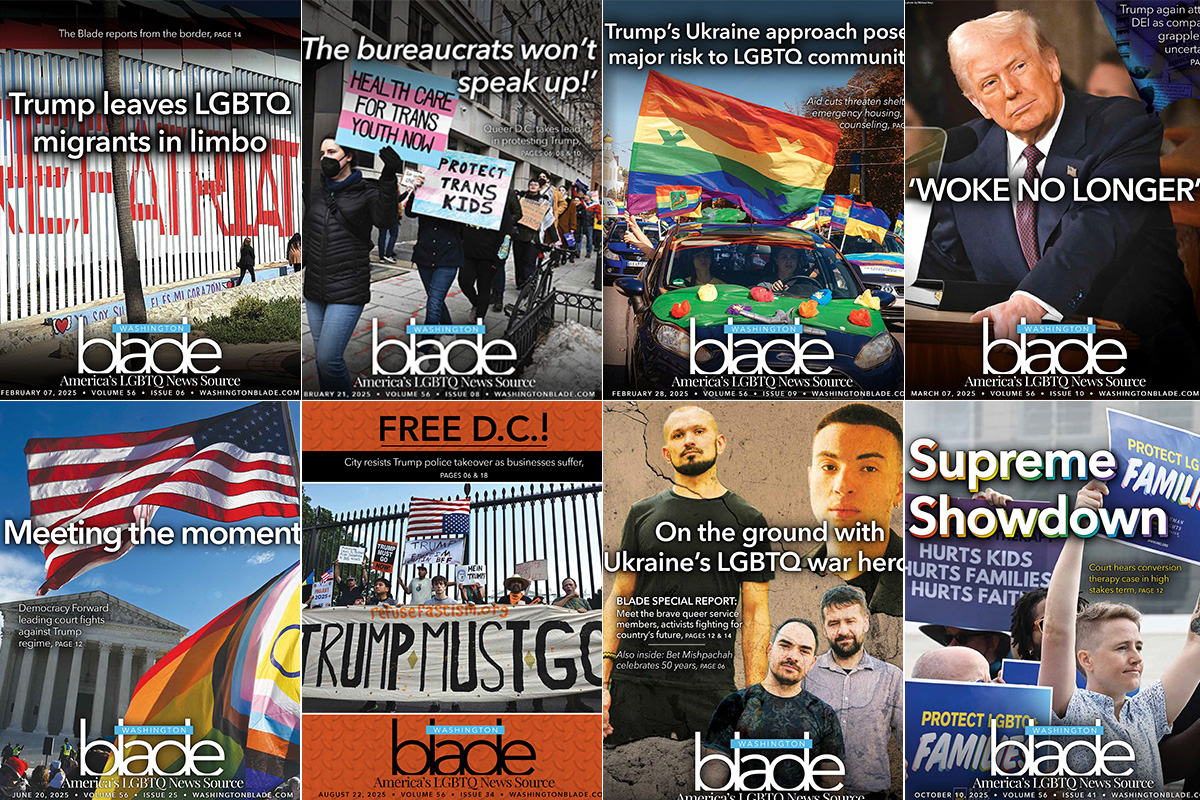
We knew it would be bad. I’m referring, of course, to 2025 and the unthinkable return of Donald Trump to the White House.
We just didn’t know how bad. The takeover of D.C. police. ICE raids and agents shooting defenseless citizens in the face. The cruel attacks on trans Americans. A compliant and complicit right-wing Supreme Court and GOP rubberstamping all the criminality and madness.
Much of that was outlined in Project 2025 and was predictable. But what has proven surprising is the speed with which major companies, powerful billionaires, and media conglomerates have hopped on board the authoritarian train and kissed Trump’s ring. Tech giants like Apple and Meta and media companies like CBS and the Washington Post have folded like cheap tents, caving to MAGA pressure and enabling Trump’s evil agenda.
The guardrails collapsed in 2025. Congress has ceded its role as a formerly co-equal branch of government. Once trusted media outlets have betrayed their audiences’ trust and morphed into propaganda arms of the White House. As a lifelong journalist, this is perhaps the most shocking and disappointing development of the past year.
The Washington Post, which adopted the ominous tagline of “Democracy Dies in Darkness,” killed its endorsement of Kamala Harris in the final days of the 2024 campaign. Same thing at the Los Angeles Times. More recently, CBS’s vaunted “60 Minutes” spiked a story critical of Trump’s immigration policies under the direction of new editor-in-chief Bari Weiss, a Trump toady and the antithesis of a journalist.
Concurrently, media companies large and small are fighting to survive. Government grants have been rescinded and the Corporation for Public Broadcasting, responsible for funding NPR and PBS, announced plans to dissolve. The Pittsburgh Post-Gazette, a nearly century-old Pulitzer Prize-winning institution, announced this week it will close on May 3. The Washington Post has lost scores of talented journalists, including prominent LGBTQ voices like Jonathan Capehart. The Baltimore Sun was acquired by the same family that owns right-wing Sinclair Broadcasting, ending a nearly 190-year tradition of award-winning, independent journalism.
It is not a coincidence that Trump’s attacks on democracy, traditions, and norms are happening while the media industry collapses. News deserts are everywhere now. In 2024, 127 newspapers closed, leaving 55 million Americans with limited or no access to local news, according to a report by Medill.
There’s a reason the media are called the “Fourth Estate.” Journalism was considered so critical to the health of our democracy that the Founding Fathers spelled it out in the First Amendment. Democracy and our Constitution cannot survive without a free and robust press.
That’s why I felt compelled to write this appeal directly to our readers. For nearly 57 years, the Blade has told the stories of LGBTQ Washington, documenting all the triumphs and heartbreaks and writing the first draft of our own history. Today, we remain hard at work, including inside the White House. This week, we have a reporter on the ground in Colombia, covering the stories of queer Venezuelan migrants amid the crisis there; another reporter will be inside the Supreme Court for next week’s trans-related cases; on Sunday, we have a reporter on the red carpet at the Golden Globes ready to interview the stars of “Heated Rivalry.”
We do a lot with a little. As major companies pull back on their support of the LGBTQ community, including their advertising in the Blade, we turn to our readers. We have never charged a dime to read the Blade in print or online. Our work remains a free and trusted resource. As we navigate these challenges, we ask that you join us. If you have the resources, please consider making a donation or purchasing a membership. If not, please subscribe to our free email newsletter. To join, visit washingtonblade.com and click on “Fund LGBTQ Journalism” in the top right navigation.
Our community is known for its resilience. At the Blade, we’ve weathered the AIDS epidemic, financial crises, and a global pandemic. We are committed to our mission and will never bend to a wannabe dictator the way so many mainstream media outlets have done. The queer press is still here and with your help we will survive these unprecedented attacks on democracy and emerge stronger than before. Thank you for reading the Blade and for considering making a donation to support our work.
Kevin Naff is editor of the Washington Blade. Reach him at [email protected].
Opinions
Time has run out for the regime in Venezuela
American forces seized Nicolás Maduro, wife on Jan. 3
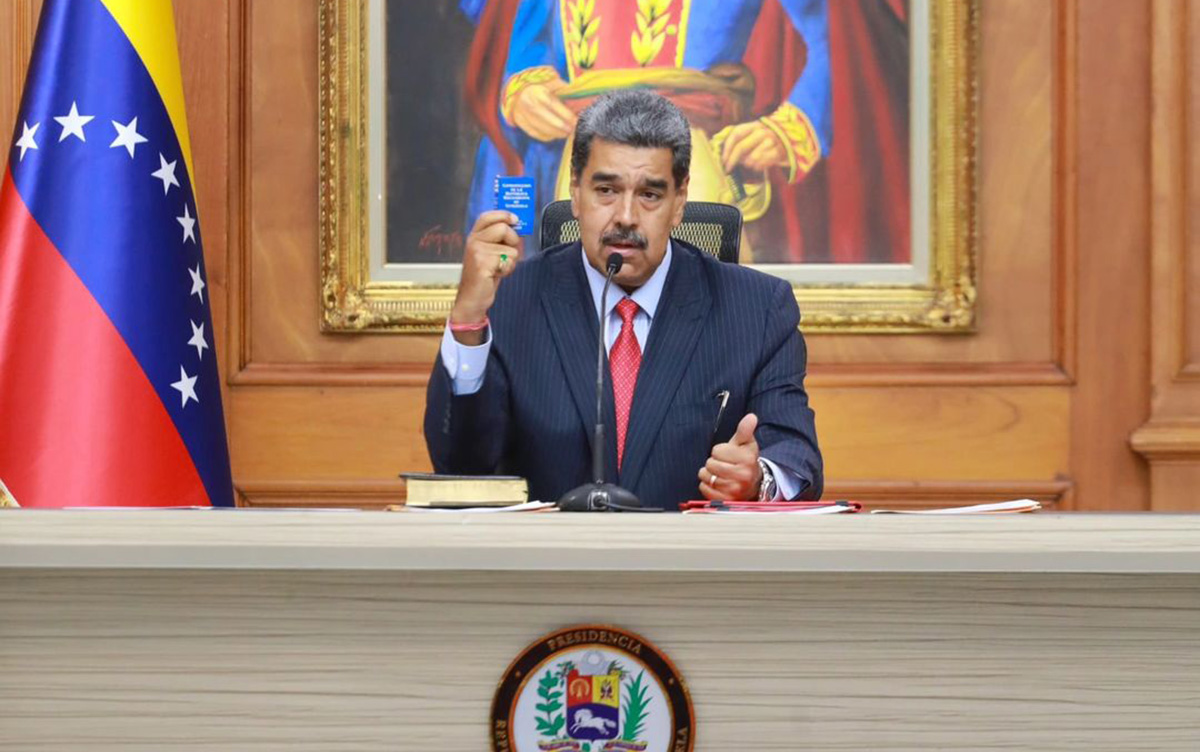
Time has run out for the regime in Venezuela.
I am fully aware that we are living through complex and critical days, not only for my country but also for the entire region. However, the capture of Nicolás Maduro has renewed hope and strengthened my conviction that we must remain firm in our cause, with the certainty that the valid reward will be to see Venezuela free from those who continue to cling illegitimately to power.
In light of this new reality, I adopt a clear, direct, and unequivocal position:
I demand the immediate release of all political prisoners.
I demand that all persons arbitrarily detained for political reasons be returned to their families immediately, without delay or conditions.
According to Foro Penal, as of Jan. 5, 2026, there are 806 political prisoners in Venezuela, including 105 women, 175 military personnel, and one adolescent, and a total of 18,623 arbitrary arrests documented since 2014. The same report documents 17 people who have died while in State custody and 875 civilians prosecuted before military courts, clearly evidencing the use of the judicial and security apparatus as instruments of political persecution. In parallel, the humanitarian system estimates that 7.9 million people in Venezuela require urgent assistance, further aggravating the impact of repression on daily life.
Behind these figures are shattered lives, separated families, and destroyed life projects. Students, activists, human rights defenders, political leaders, and members of the armed forces remain imprisoned without judicial guarantees, without due process, and without justice.
Since the capture of Nicolás Maduro, repression has not ceased. On the contrary, more than ten journalists have been arbitrarily detained, while others have been harassed, imprisoned, or mistreated for carrying out their duty to inform. Today, journalism in Venezuela has become a heroic and high-risk act.
This situation is further aggravated by a new attack on fundamental freedoms: an illegitimate decree of “external state of emergency”, whose purpose is to legalize state terrorism, expand the scope of repression, and deepen the criminalization of dissent and freedom of expression.
The destruction of freedoms cannot and must not be normalized, either by society or by the international community.
I do not forget the atrocities committed against people deprived of their liberty: systematic violations of due process, torture, cruel, inhuman, and degrading treatment, denial of medical care, and prolonged isolation.
These practices have been widely documented and denounced and are currently under investigation by international justice mechanisms.
In this regard, the United Nations Independent International Fact-Finding Mission on Venezuela has repeatedly expressed grave concern over the persistence of serious human rights violations, including the use of torture, enforced isolation, and the responsibility of State security forces in systematic abuses, as reflected in its statements and reports issued on Jan. 3, 2026, and throughout 2025.
From my unwavering commitment to human rights, I issue a firm and urgent call to Venezuelan citizens and to all people in the free and democratic world to stand together in defense of human dignity.
All political prisoners must be released now.
All torture and detention centers must be closed.
I am convinced that there can be no genuine democratic transition without the immediate release of political prisoners, the submission to justice of those responsible for arbitrary detentions, and the establishment of accountability mechanisms, guarantees of non-repetition, and full reparation for victims and their families. This is the only viable path toward a proper transition to democracy in Venezuela.
Today, more than ever, I stand in solidarity, inside and outside Venezuela, with the victims and their families.
This is a moment of definition, not of silence or hesitation.
I assume, together with millions of Venezuelans, that we are co-responsible for our collective reality and for the new Venezuela that we are called to rebuild.
Dignity, freedom, and justice cannot wait.
Freedom for Venezuela.
Juan Carlos Viloria Doria is president of the Global Alliance for Human Rights and vice president of Venezolanos en Barranquilla, an NGO based in Barranquilla, Colombia.
Opinions
Just say no to the felon in the White House
Democrats, media must do more to oppose Trump’s agenda
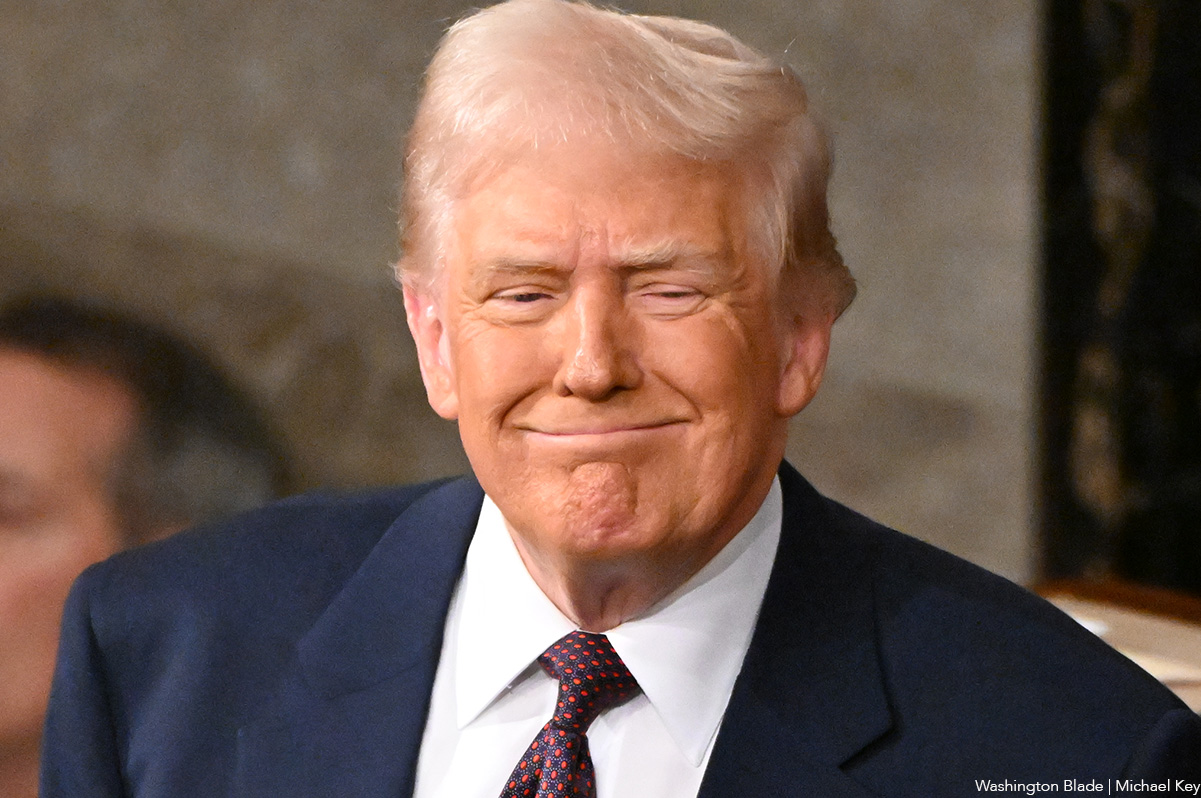
We have a clearly deranged, sick, felon as president, who can’t even remember if he had an MRI, or a CT. He says he takes enough aspirin to keep his blood running thin in his veins. He fakes health reports, and lies every time he opens his mouth. His brain appears foggier than Joe Biden’s ever was.
The felon arranged to get a fake Peace Prize from the soccer federation, while taking military actions around the world. He sanctioned American attacks on Nigeria, Iran, Syria, and now on the government, and people, of Venezuela. He has our military attacking boats, claiming they are carrying drugs, with no proof. He interferes in foreign elections, making the United States less safe. He obviously supports Putin in his war against Ukraine, and supports Netanyahu’s destruction of Gaza, and his starvation of the Palestinian people there. Because of all this it’s understandable why he calls his Secretary of Defense, his Secretary of War. That individual being unqualified with no competence, or decency — the perfect toady for the fascists surrounding Trump. He has a Secretary of State in Marco Rubio who clearly has no principles at all. Rubio previously said, “Donald Trump – a con artist – will never get control of this party…We cannot allow a con artist to get access to the nuclear codes of the United States of America.” He compared Trump to a “third-world strong man.” Now as Secretary of State he justifies all the illegal actions the felon takes.
I, and many others, question “Where is Congress in all this?” Do no Republicans in Congress have any cojones? Two Republican woman have criticized Trump — Marjorie Taylor Greene (R-Ga.) and Nancy Mace (R-S.C.). Both on the Epstein files, one on screwing the American people with regard to their health insurance. Both are now out of Congress, still MAGA, but found if you disagree with the felon, he sics his cult on you.
My other question is: When will any in the media really stand up to him? When do mainstream media call out every one of his lies, as he makes them? When do they show any guts, and repeat each day he is deranged? When do they have daily headlines, calling him out on things from his health reports, to lies about the economy? Where are the daily headlines calling out the Republican Congress for its lack of action? Why is there no representative clock on every TV network, ticking off the time Congress doesn’t take back their rightful place as an equal branch of government? When will they call out the Supreme Court, reminding people what Trump’s picks said during their confirmations, versus what they are doing now? When will they actually reclaim ‘The freedom of the press?’
Democrats must continue to speak out. I am aware they have little power in this Congress, but they must not remain silent. We have seen, when they do speak up, we win elections. They help the people to wake up, as they did in recent elections in New Jersey and Virginia. In races as distinct as the mayoralty of Miami, where a Democrat won for the first time in 30 years, and did so in a landslide; and Democrats won two special elections for State Senate in Mississippi. In Georgia, Democrats won two seats on the Georgia Public Service Commission, the first time in 20 years they won a statewide seat. And they won a State Senate seat in Iowa, and the redistricting vote in California.
To continue winning Democrats must remind people every day what the felon, and his fascist cohorts, are doing to destroy their lives. Latinos and Hispanics need a daily reminder, it is the felon who once said he supports them, whose government is now deporting them. Young people must be reminded every day, the felon is destroying the country they will inherit, their future, by denying climate change. Everyone needs daily reminders how he is destroying the health of the country. Ending research grants looking for cures for cancer, Alzheimer’s, Parkinson’s, and HIV/AIDS. Ending research grants into curing childhood diseases, development of mRNA vaccines, and other potential progress to protect Americans, and the world, when the next pandemic occurs, and it will. He is literally killing children by having his government speak out against vaccinations for illnesses like measles, considered eradicated before he came into office.
All of this needs to be headlined each day in our newspapers, and on TV, by the people who still can, and are willing, to do it. Those not bought off by, or afraid of, the felon, and his fascist cohorts. Those who don’t sit with him at Mar-a-Lago, and have become his enablers. We the people need to take to the streets and every time there is an election, use our vote to say to the sick, deranged, felon, and his fascist cohorts, ‘NO MORE’.
Peter Rosenstein is a longtime LGBTQ rights and Democratic Party activist.
-

 Colombia5 days ago
Colombia5 days agoGay Venezuelan man who fled to Colombia uncertain about homeland’s future
-

 Arts & Entertainment5 days ago
Arts & Entertainment5 days ago2026 Most Eligible LGBTQ Singles nominations
-

 District of Columbia4 days ago
District of Columbia4 days agoKennedy Center renaming triggers backlash
-

 District of Columbia5 days ago
District of Columbia5 days agoNew interim D.C. police chief played lead role in security for WorldPride

